
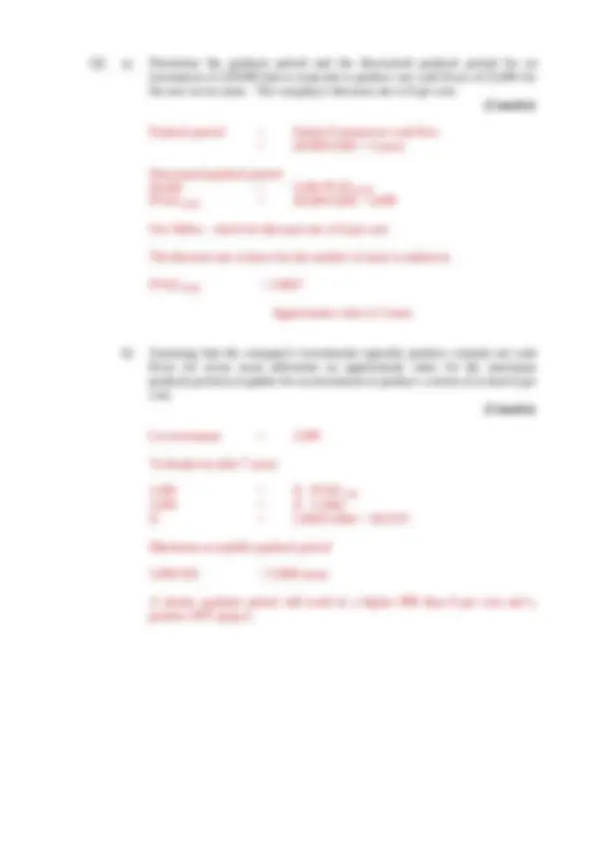
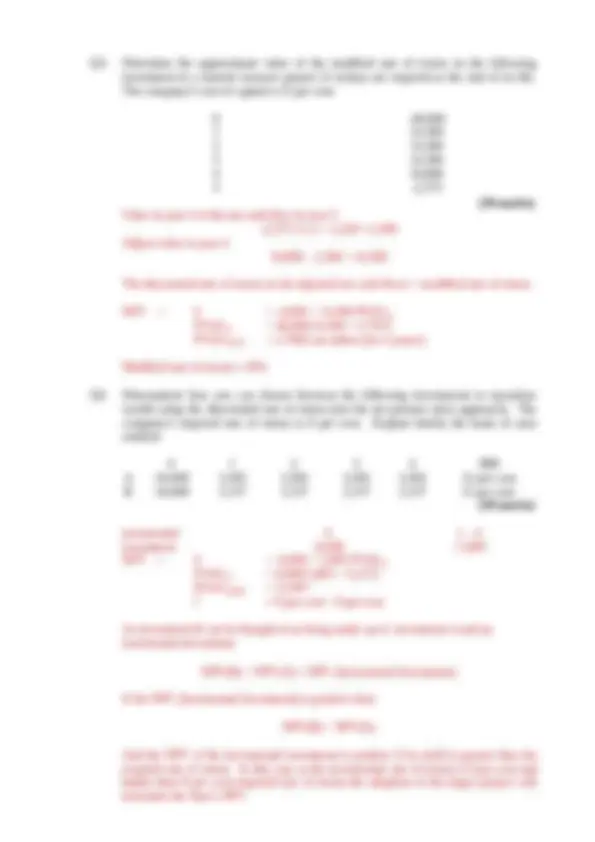
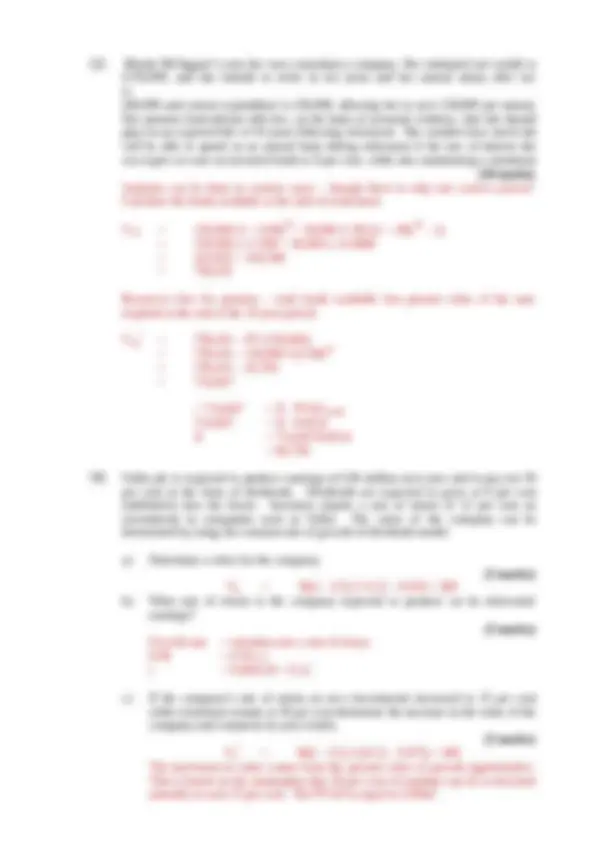
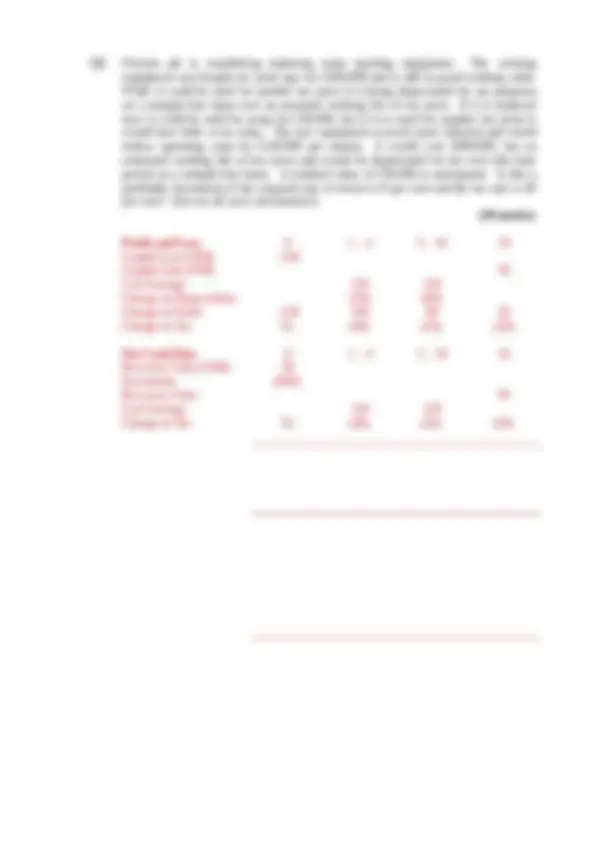
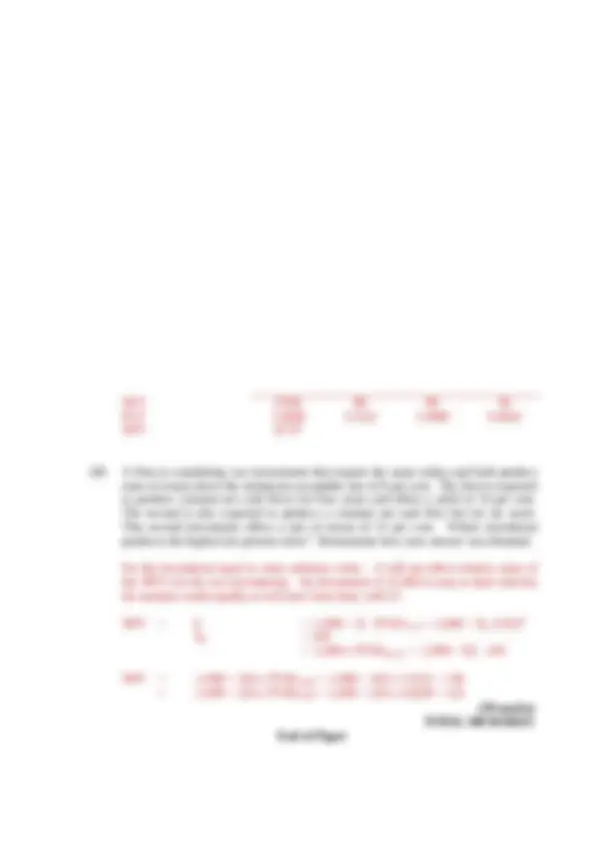


Study with the several resources on Docsity

Earn points by helping other students or get them with a premium plan


Prepare for your exams
Study with the several resources on Docsity

Earn points to download
Earn points by helping other students or get them with a premium plan
Community
Ask the community for help and clear up your study doubts
Discover the best universities in your country according to Docsity users
Free resources
Download our free guides on studying techniques, anxiety management strategies, and thesis advice from Docsity tutors
Financial analysis examples for determining the internal rates of return (irr) and net present values (npv) of various investments. It includes calculations for single cash inflows, constant net cash flows, perpetuities, and loans. The document also covers the payback period and discounted payback period.
Typology: Study Guides, Projects, Research
1 / 9

This page cannot be seen from the preview
Don't miss anything!






M.Sc. Finance (A4) 1 of 7 To Be Completed (please write clearly)
th
Calculators must not be used to store text and/or formulae nor be capable of communication. Invigilators may require calculators to be reset. All answers are to be written in the spaces provided in ink. Please write clearly as illegible writing cannot be marked. If more space is required the answer can be continued on the back of the page where the question appears. Failure to follow these requirements will lead to a deduction of marks.
For Examiners Use Only Comments
Q1. a) Determine the approximate value of the internal rate of return on an investment of £6,000 that is expected to produce a single cash inflow of £11,550 in year 5. (5 marks) NPV = 0 = -6,000 + 11,550 1/(1 + i) 5 (1 + i) 5 = 11,550/6,000 = 1. (1 + i) = 5 √1.925 = 1. i = 0. b) Determine the approximate value of the internal rate of return on an investment of £20,000 that is expected to produce a constant net cash flow of £6,580 for the next four years. (5 marks) NPV = 0 = -2,000 + 6,580 PVAF4/i PVAF4/i = 20,000/6,580 = 3. PVAF4/0. 12 = 3. i ≈ 12 per cent c) An investment of £30,000 is expected to produce a constant net cash flow in perpetuity and offers a yield of 12 per cent whereas the required rate of return is 10 per cent. Determine its net present value and briefly interpret your answer. (5 marks) NPV = 30,000 = [(0.12 – 0.10)/.10] = 6, C = i I = 0.12 x 30,000 = 3, NPV = -30,000 + 3,600 1/0.10 = 6, As the investment is a perpetuity the net cash flow can be determine as the rate of return times the capital outlay. The NPV can then be derived, treating the next cash flow as a perpetuity. d) A loan of £10,00 0 is to be paid off in four equal annual payments and the rate of interest on the balance of the loan is 6 per cent (the payments cover the repayment of capital plus interest). Determine the annual payment. ( 5 marks) Loan = PV (Repayments at the contractual rate of interest) 10,000 = X · PVAF4/. 06 = X · 3. X = 10,000/3.4651 = 2,
Q3. Determine the approximate value of the modified rate of return on the following investment in a natural resource project if outlays are required at the end of its life. The company’s cost of capital is 12 per cent. 0 -40, 1 14, 2 14, 3 14, 4 16, 5 -2, Value in year 4 of the net cash flow in year 5 -2,575 1/1.2 = 2,229 ≈ 2, (10 marks) Adjust value in year 4 16,600 – 2,300 = 14, The discounted rate of return on the adjusted net cash flows = modified rate of return NPV = 0 = -4,000 + 14,300 PVAF4/i PVAF4/i = 40,000/14,300 = 2. PVAF4/0. 16 = 2.7982 use tables (for 4 years!) Modified rate of return ≈ 16% Q4. Demonstrate how you can choose between the following investments to maximise wealth using the discounted rate of return (not the net present value approach). The company’s required rate of return is 8 per cent. Explain briefly the basis of your analysis 0 1 2 3 4 IRR A -10,000 3,292 3,292 3,292 3,292 12 per cent B -16,000 5,157 5,157 5,157 5,157 11 per cent (10 marks) incremental 0 1 – 4 investment -6,000 +1, NPV = 0 = -6,000 + 1,865 PVAF4/i PVAF4/i = 6,000/1,865 = 3. PVAF4/0. 09 = 3. i
≈ 9 per cent > 8 per cent As investment B can be thought of as being made up of investment A and an incremental investment NPV(B) = NPV(A) ± NPV (Incremental Investment) If the NPV (Incremental Investment) is positive then NPV(B) > NPV(A) And the NPV of the incremental investment is positive if its yield is greater than the required rate of return. In this case as the incremental rate of return is 9 per cent and higher than 8 per cent required rate of return the adoption of the larger project will maximise the firm’s NPV.
Q5. Rhoda McTaggart’s runs her own consultancy company. Her estimated net wealth is £150,000, and she intends to retire in ten years and her annual salary after tax is £80,00 0 and current expenditure is £50,000, allowing her to save £30,00 0 per annum. Her pension fund advisor tells her, on the basis of actuarial evidence, that she should plan on an expected life of 16 years following retirement. She wonders how much she will be able to spend on an annual basis during retirement if the rate of interest she can expect to earn on invested funds is 8 per cent, while also maintaining a minimum wealth position of £150,00 0 after the expected 16 years of retirement. (1 0 marks) Q6. Analysis can be done in various ways – though there is only one correct answer! Calculate the funds available at the start of retirement. V 10 = 150,000 (1 + 0.08) 10
= 150,000 x 2.1589 + 30,000 x 14. = 323,835 + 434, = 758, Resources free for pension – total funds available less present value of the sum required at the end of the 16 year period. V 10
= 758,431 – PV (150,000) = 758,431 – 150,000 1/(1.08) 16 = 758,431 – 43, = 714,
= 36(1 – 0.5) 1/(0.12 – 0.075) = 400 The increment in value comes from the present value of growth opportunities. This is based on the assumption that 50 per cent of earnings can be re-invested annually to earn 15 per cent. The PVGO is equal to £100m.
Q7. The price earnings ratios reported in the Financial Times for Stirling Electronics and Resolven Electronics are 16/1and 24/ 1 respectively. Both companies operate in the same industrial sector and are about the same size. Identify factors that might account for the differences in their price-earnings ratios. The price-earnings raio can be derived from the valuation models. ( 5 marks) P 0 =
E 1 r E 1 r − bi The P/E ratio will be higher
Q8. Friction plc is considering replacing some stacking equipment. The existing equipment was bought six years ago for £400,000 and is still in good working order. While it could be used for another ten years it is being depreciated for tax purposes on a straight line basis over an assumed working life of ten years. If it is replaced now it could be sold for scrap for £30,000, but if it is used for another ten years it would have little or no value. The new equipment is much more efficient and would reduce operating costs by £120,000 per annum. It would cost £600,000, has an estimated working life of ten years and would be depreciated for tax over this time period on a straight line basis. A residual value of £50,000 is anticipated. Is this a profitable investment if the required rate of return is 8 per cent and the tax rate is 40 per cent? (Set out all your calculations!) (10 marks) Profit and Loss 0 1 – 4 5 – 10 10 Capital Loss (OM) - Capital Gain (NM) 50 Cost Savings 120 120 Change in Depreciation (20) (60) Change in Profit -130 100 60 50 Change in Tax 52 (40) (24) (20) Net Cash Flow 0 1 – 4 5 – 10 10 Recovery Value (OM) 30 Investment (600) Recovery Value 50 Cost Savings 120 120 Change in Tax 52 (40) (24) (20)